Colorectal Cancer: Case Study, Treatment, and Patient Education
VerifiedAdded on 2021/05/27
|10
|2438
|58
Report
AI Summary
This report presents a comprehensive case study of a 65-year-old male diagnosed with colorectal cancer. It details his symptoms, the diagnostic process including colonoscopy and CT scans, and the subsequent treatment plan involving surgery and adjuvant chemotherapy with calcium folinate and fluorouracil. The report outlines the importance of follow-up care, including regular physical examinations and tests like CEA, CT scans, colonoscopies, and rectosigmoidoscopy to monitor for recurrence. It further explores the signs and symptoms of recurrence, as well as a self-management plan addressing physical, psychological, and social challenges faced by the patient. The plan includes strategies for managing fatigue, pain, and psychological distress, as well as advice on social support and spiritual coping mechanisms. The report emphasizes the importance of health education, including lifestyle modifications such as avoiding smoking, adopting a healthy diet, and engaging in regular physical activity to improve outcomes and reduce the risk of recurrence. The case study concludes with a summary of the patient's journey and recommendations for effective patient care.
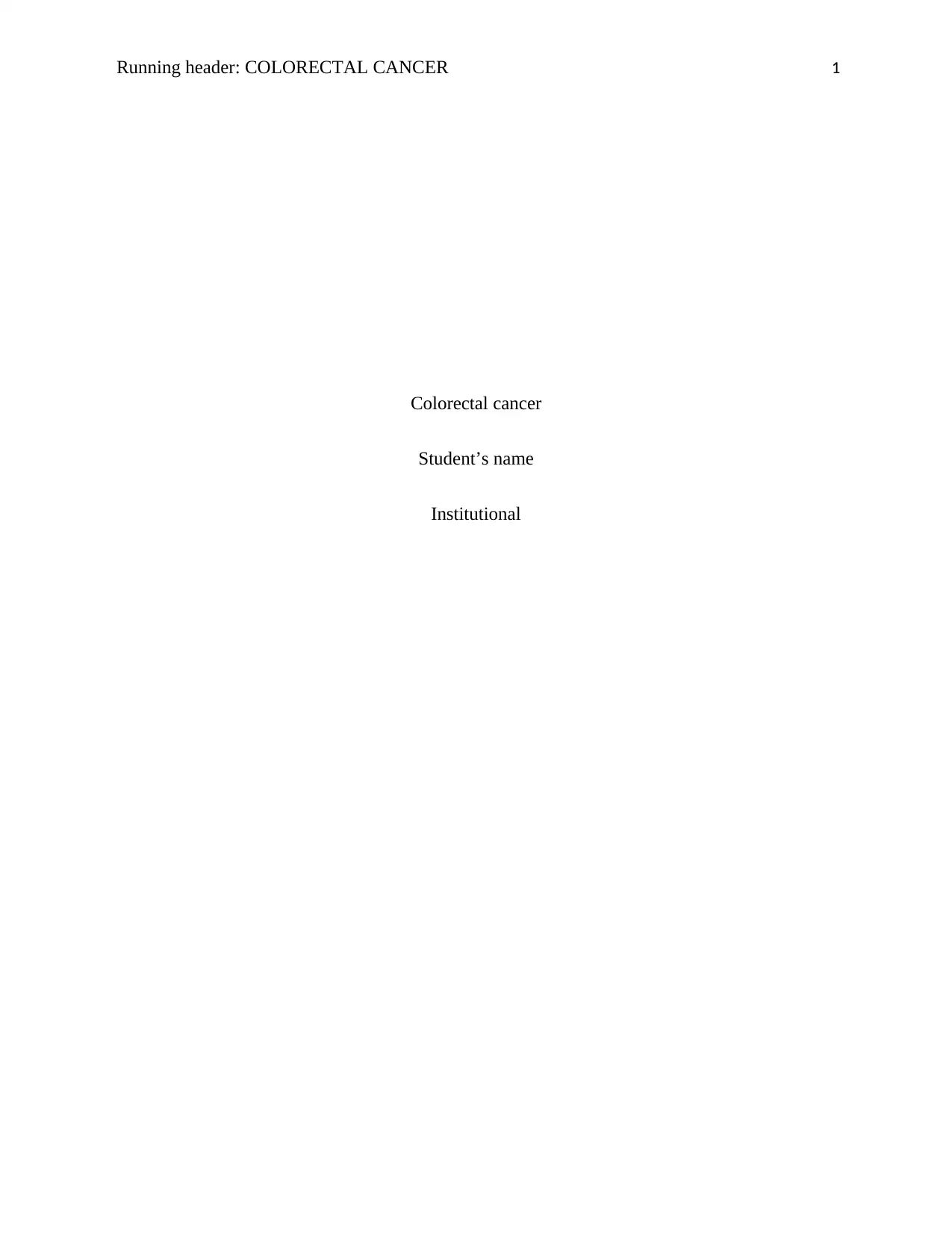
Running header: COLORECTAL CANCER 1
Colorectal cancer
Student’s name
Institutional
Colorectal cancer
Student’s name
Institutional
Paraphrase This Document
Need a fresh take? Get an instant paraphrase of this document with our AI Paraphraser
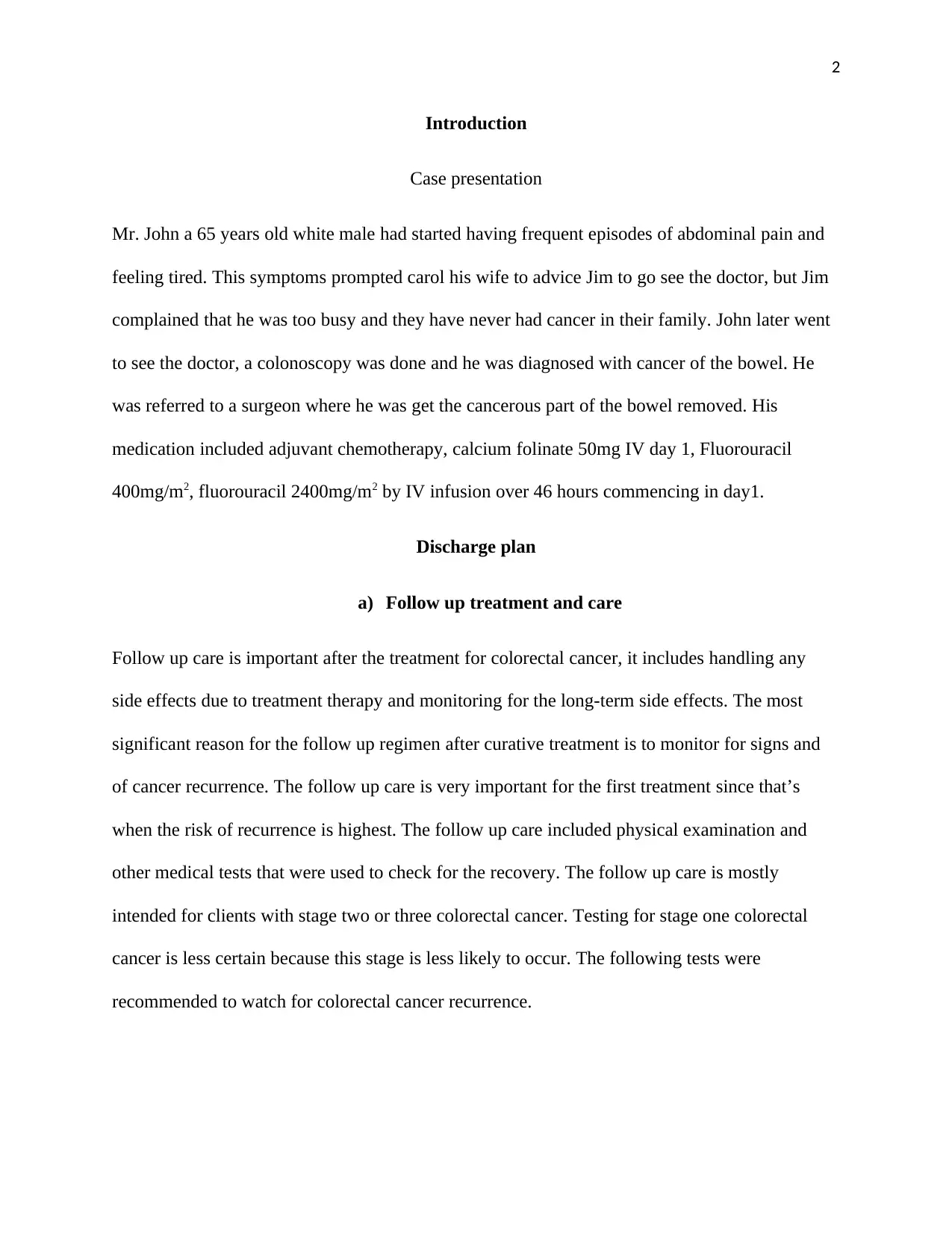
2
Introduction
Case presentation
Mr. John a 65 years old white male had started having frequent episodes of abdominal pain and
feeling tired. This symptoms prompted carol his wife to advice Jim to go see the doctor, but Jim
complained that he was too busy and they have never had cancer in their family. John later went
to see the doctor, a colonoscopy was done and he was diagnosed with cancer of the bowel. He
was referred to a surgeon where he was get the cancerous part of the bowel removed. His
medication included adjuvant chemotherapy, calcium folinate 50mg IV day 1, Fluorouracil
400mg/m2, fluorouracil 2400mg/m2 by IV infusion over 46 hours commencing in day1.
Discharge plan
a) Follow up treatment and care
Follow up care is important after the treatment for colorectal cancer, it includes handling any
side effects due to treatment therapy and monitoring for the long-term side effects. The most
significant reason for the follow up regimen after curative treatment is to monitor for signs and
of cancer recurrence. The follow up care is very important for the first treatment since that’s
when the risk of recurrence is highest. The follow up care included physical examination and
other medical tests that were used to check for the recovery. The follow up care is mostly
intended for clients with stage two or three colorectal cancer. Testing for stage one colorectal
cancer is less certain because this stage is less likely to occur. The following tests were
recommended to watch for colorectal cancer recurrence.
Introduction
Case presentation
Mr. John a 65 years old white male had started having frequent episodes of abdominal pain and
feeling tired. This symptoms prompted carol his wife to advice Jim to go see the doctor, but Jim
complained that he was too busy and they have never had cancer in their family. John later went
to see the doctor, a colonoscopy was done and he was diagnosed with cancer of the bowel. He
was referred to a surgeon where he was get the cancerous part of the bowel removed. His
medication included adjuvant chemotherapy, calcium folinate 50mg IV day 1, Fluorouracil
400mg/m2, fluorouracil 2400mg/m2 by IV infusion over 46 hours commencing in day1.
Discharge plan
a) Follow up treatment and care
Follow up care is important after the treatment for colorectal cancer, it includes handling any
side effects due to treatment therapy and monitoring for the long-term side effects. The most
significant reason for the follow up regimen after curative treatment is to monitor for signs and
of cancer recurrence. The follow up care is very important for the first treatment since that’s
when the risk of recurrence is highest. The follow up care included physical examination and
other medical tests that were used to check for the recovery. The follow up care is mostly
intended for clients with stage two or three colorectal cancer. Testing for stage one colorectal
cancer is less certain because this stage is less likely to occur. The following tests were
recommended to watch for colorectal cancer recurrence.
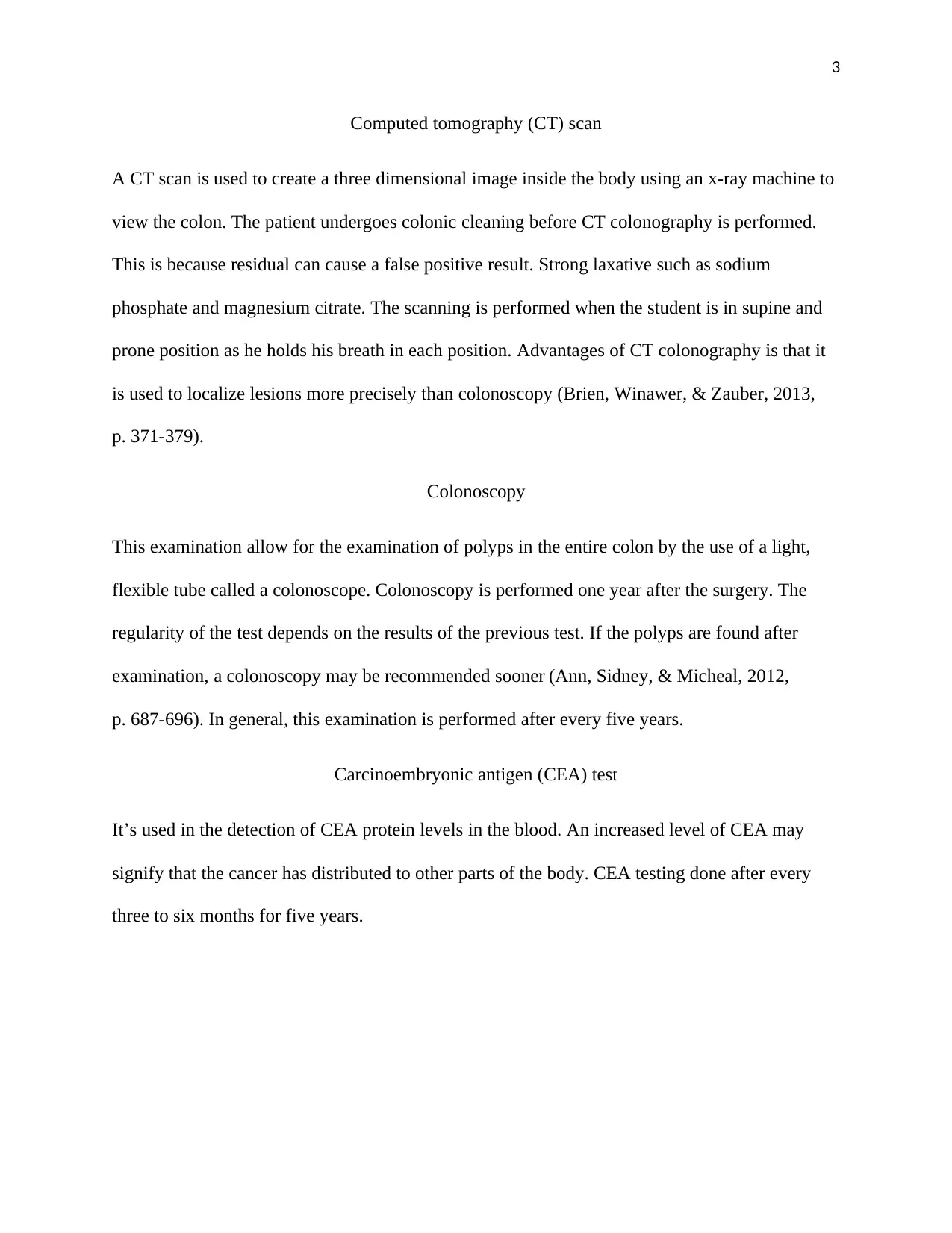
3
Computed tomography (CT) scan
A CT scan is used to create a three dimensional image inside the body using an x-ray machine to
view the colon. The patient undergoes colonic cleaning before CT colonography is performed.
This is because residual can cause a false positive result. Strong laxative such as sodium
phosphate and magnesium citrate. The scanning is performed when the student is in supine and
prone position as he holds his breath in each position. Advantages of CT colonography is that it
is used to localize lesions more precisely than colonoscopy (Brien, Winawer, & Zauber, 2013,
p. 371-379).
Colonoscopy
This examination allow for the examination of polyps in the entire colon by the use of a light,
flexible tube called a colonoscope. Colonoscopy is performed one year after the surgery. The
regularity of the test depends on the results of the previous test. If the polyps are found after
examination, a colonoscopy may be recommended sooner (Ann, Sidney, & Micheal, 2012,
p. 687-696). In general, this examination is performed after every five years.
Carcinoembryonic antigen (CEA) test
It’s used in the detection of CEA protein levels in the blood. An increased level of CEA may
signify that the cancer has distributed to other parts of the body. CEA testing done after every
three to six months for five years.
Computed tomography (CT) scan
A CT scan is used to create a three dimensional image inside the body using an x-ray machine to
view the colon. The patient undergoes colonic cleaning before CT colonography is performed.
This is because residual can cause a false positive result. Strong laxative such as sodium
phosphate and magnesium citrate. The scanning is performed when the student is in supine and
prone position as he holds his breath in each position. Advantages of CT colonography is that it
is used to localize lesions more precisely than colonoscopy (Brien, Winawer, & Zauber, 2013,
p. 371-379).
Colonoscopy
This examination allow for the examination of polyps in the entire colon by the use of a light,
flexible tube called a colonoscope. Colonoscopy is performed one year after the surgery. The
regularity of the test depends on the results of the previous test. If the polyps are found after
examination, a colonoscopy may be recommended sooner (Ann, Sidney, & Micheal, 2012,
p. 687-696). In general, this examination is performed after every five years.
Carcinoembryonic antigen (CEA) test
It’s used in the detection of CEA protein levels in the blood. An increased level of CEA may
signify that the cancer has distributed to other parts of the body. CEA testing done after every
three to six months for five years.
⊘ This is a preview!⊘
Do you want full access?
Subscribe today to unlock all pages.

Trusted by 1+ million students worldwide
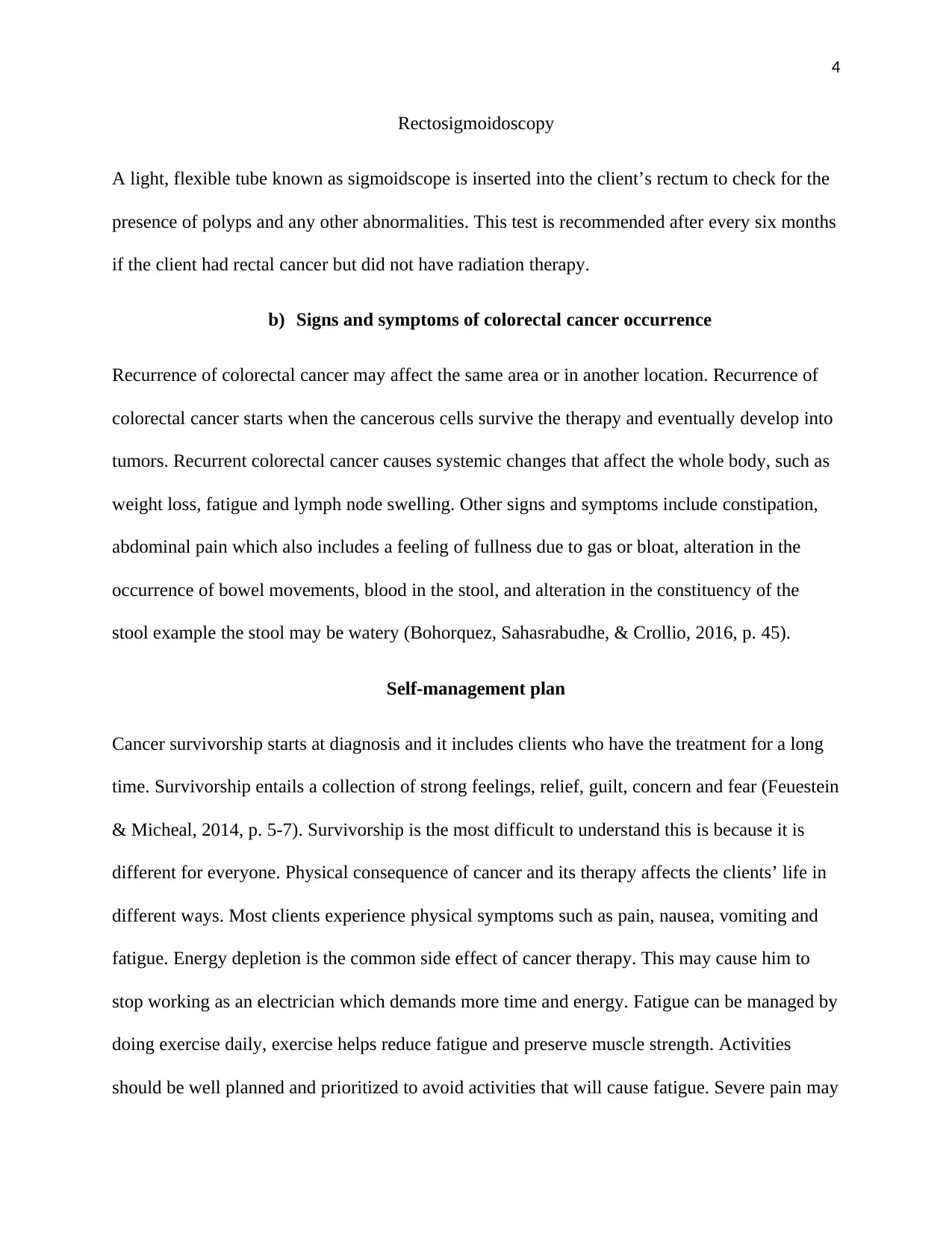
4
Rectosigmoidoscopy
A light, flexible tube known as sigmoidscope is inserted into the client’s rectum to check for the
presence of polyps and any other abnormalities. This test is recommended after every six months
if the client had rectal cancer but did not have radiation therapy.
b) Signs and symptoms of colorectal cancer occurrence
Recurrence of colorectal cancer may affect the same area or in another location. Recurrence of
colorectal cancer starts when the cancerous cells survive the therapy and eventually develop into
tumors. Recurrent colorectal cancer causes systemic changes that affect the whole body, such as
weight loss, fatigue and lymph node swelling. Other signs and symptoms include constipation,
abdominal pain which also includes a feeling of fullness due to gas or bloat, alteration in the
occurrence of bowel movements, blood in the stool, and alteration in the constituency of the
stool example the stool may be watery (Bohorquez, Sahasrabudhe, & Crollio, 2016, p. 45).
Self-management plan
Cancer survivorship starts at diagnosis and it includes clients who have the treatment for a long
time. Survivorship entails a collection of strong feelings, relief, guilt, concern and fear (Feuestein
& Micheal, 2014, p. 5-7). Survivorship is the most difficult to understand this is because it is
different for everyone. Physical consequence of cancer and its therapy affects the clients’ life in
different ways. Most clients experience physical symptoms such as pain, nausea, vomiting and
fatigue. Energy depletion is the common side effect of cancer therapy. This may cause him to
stop working as an electrician which demands more time and energy. Fatigue can be managed by
doing exercise daily, exercise helps reduce fatigue and preserve muscle strength. Activities
should be well planned and prioritized to avoid activities that will cause fatigue. Severe pain may
Rectosigmoidoscopy
A light, flexible tube known as sigmoidscope is inserted into the client’s rectum to check for the
presence of polyps and any other abnormalities. This test is recommended after every six months
if the client had rectal cancer but did not have radiation therapy.
b) Signs and symptoms of colorectal cancer occurrence
Recurrence of colorectal cancer may affect the same area or in another location. Recurrence of
colorectal cancer starts when the cancerous cells survive the therapy and eventually develop into
tumors. Recurrent colorectal cancer causes systemic changes that affect the whole body, such as
weight loss, fatigue and lymph node swelling. Other signs and symptoms include constipation,
abdominal pain which also includes a feeling of fullness due to gas or bloat, alteration in the
occurrence of bowel movements, blood in the stool, and alteration in the constituency of the
stool example the stool may be watery (Bohorquez, Sahasrabudhe, & Crollio, 2016, p. 45).
Self-management plan
Cancer survivorship starts at diagnosis and it includes clients who have the treatment for a long
time. Survivorship entails a collection of strong feelings, relief, guilt, concern and fear (Feuestein
& Micheal, 2014, p. 5-7). Survivorship is the most difficult to understand this is because it is
different for everyone. Physical consequence of cancer and its therapy affects the clients’ life in
different ways. Most clients experience physical symptoms such as pain, nausea, vomiting and
fatigue. Energy depletion is the common side effect of cancer therapy. This may cause him to
stop working as an electrician which demands more time and energy. Fatigue can be managed by
doing exercise daily, exercise helps reduce fatigue and preserve muscle strength. Activities
should be well planned and prioritized to avoid activities that will cause fatigue. Severe pain may
Paraphrase This Document
Need a fresh take? Get an instant paraphrase of this document with our AI Paraphraser
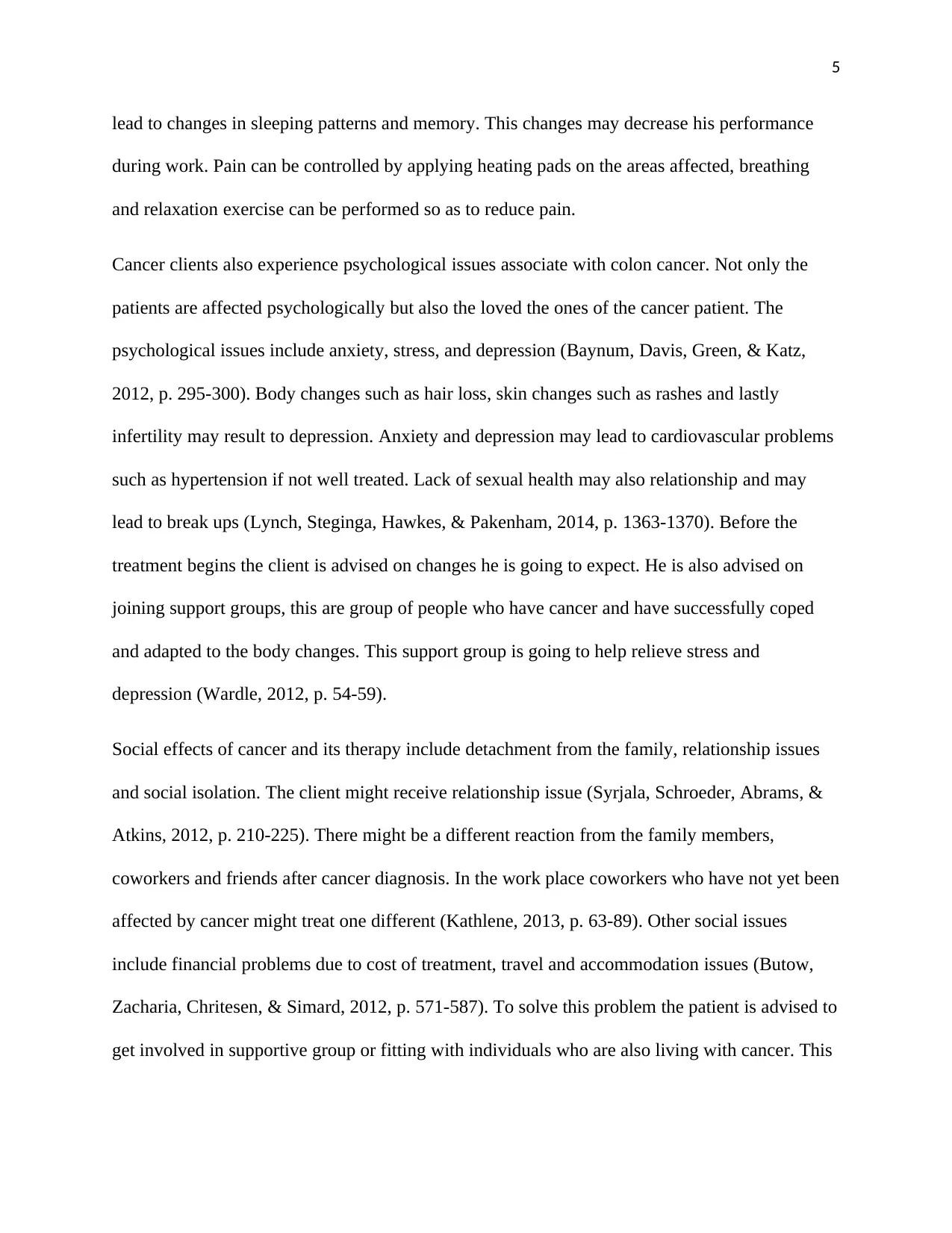
5
lead to changes in sleeping patterns and memory. This changes may decrease his performance
during work. Pain can be controlled by applying heating pads on the areas affected, breathing
and relaxation exercise can be performed so as to reduce pain.
Cancer clients also experience psychological issues associate with colon cancer. Not only the
patients are affected psychologically but also the loved the ones of the cancer patient. The
psychological issues include anxiety, stress, and depression (Baynum, Davis, Green, & Katz,
2012, p. 295-300). Body changes such as hair loss, skin changes such as rashes and lastly
infertility may result to depression. Anxiety and depression may lead to cardiovascular problems
such as hypertension if not well treated. Lack of sexual health may also relationship and may
lead to break ups (Lynch, Steginga, Hawkes, & Pakenham, 2014, p. 1363-1370). Before the
treatment begins the client is advised on changes he is going to expect. He is also advised on
joining support groups, this are group of people who have cancer and have successfully coped
and adapted to the body changes. This support group is going to help relieve stress and
depression (Wardle, 2012, p. 54-59).
Social effects of cancer and its therapy include detachment from the family, relationship issues
and social isolation. The client might receive relationship issue (Syrjala, Schroeder, Abrams, &
Atkins, 2012, p. 210-225). There might be a different reaction from the family members,
coworkers and friends after cancer diagnosis. In the work place coworkers who have not yet been
affected by cancer might treat one different (Kathlene, 2013, p. 63-89). Other social issues
include financial problems due to cost of treatment, travel and accommodation issues (Butow,
Zacharia, Chritesen, & Simard, 2012, p. 571-587). To solve this problem the patient is advised to
get involved in supportive group or fitting with individuals who are also living with cancer. This
lead to changes in sleeping patterns and memory. This changes may decrease his performance
during work. Pain can be controlled by applying heating pads on the areas affected, breathing
and relaxation exercise can be performed so as to reduce pain.
Cancer clients also experience psychological issues associate with colon cancer. Not only the
patients are affected psychologically but also the loved the ones of the cancer patient. The
psychological issues include anxiety, stress, and depression (Baynum, Davis, Green, & Katz,
2012, p. 295-300). Body changes such as hair loss, skin changes such as rashes and lastly
infertility may result to depression. Anxiety and depression may lead to cardiovascular problems
such as hypertension if not well treated. Lack of sexual health may also relationship and may
lead to break ups (Lynch, Steginga, Hawkes, & Pakenham, 2014, p. 1363-1370). Before the
treatment begins the client is advised on changes he is going to expect. He is also advised on
joining support groups, this are group of people who have cancer and have successfully coped
and adapted to the body changes. This support group is going to help relieve stress and
depression (Wardle, 2012, p. 54-59).
Social effects of cancer and its therapy include detachment from the family, relationship issues
and social isolation. The client might receive relationship issue (Syrjala, Schroeder, Abrams, &
Atkins, 2012, p. 210-225). There might be a different reaction from the family members,
coworkers and friends after cancer diagnosis. In the work place coworkers who have not yet been
affected by cancer might treat one different (Kathlene, 2013, p. 63-89). Other social issues
include financial problems due to cost of treatment, travel and accommodation issues (Butow,
Zacharia, Chritesen, & Simard, 2012, p. 571-587). To solve this problem the patient is advised to
get involved in supportive group or fitting with individuals who are also living with cancer. This
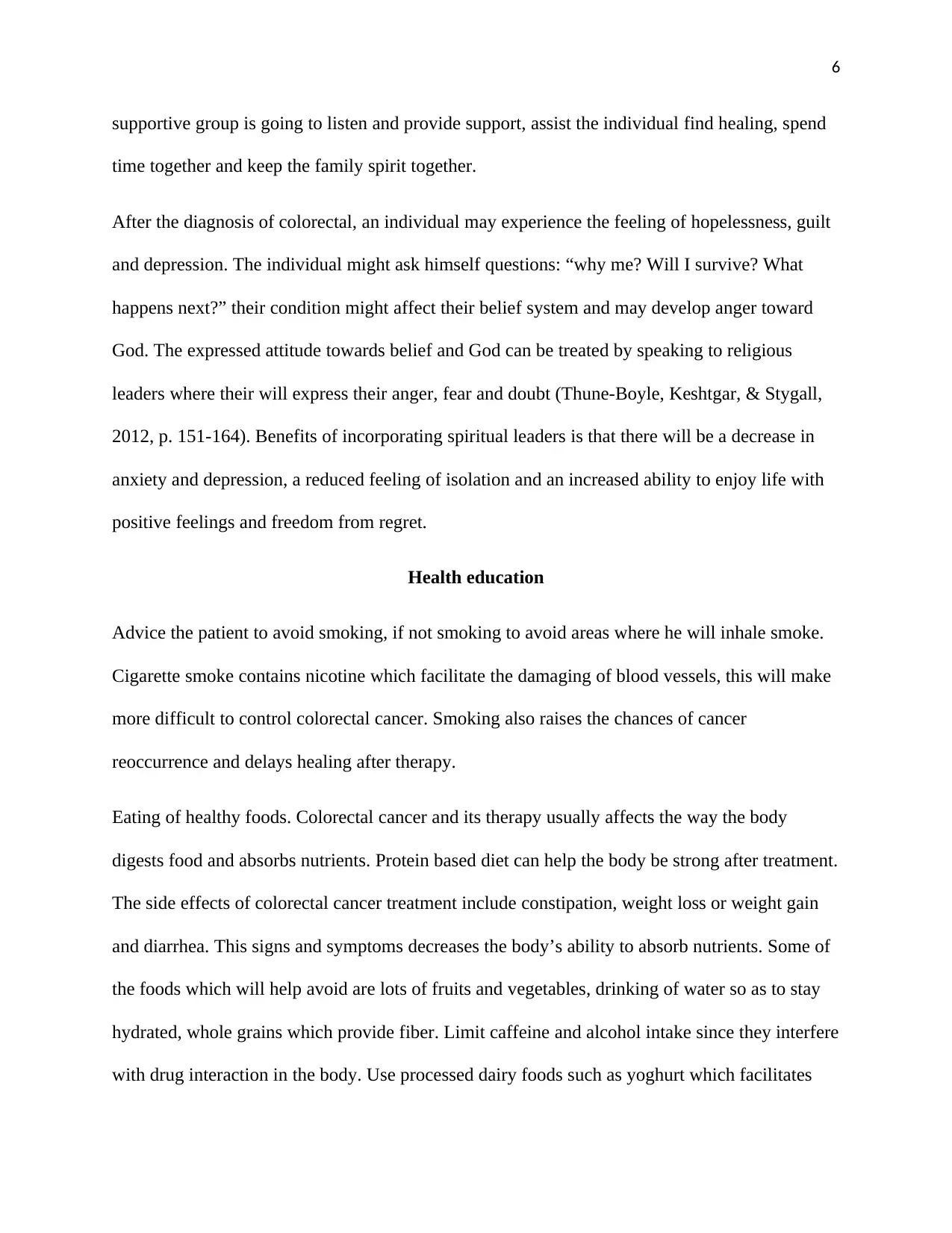
6
supportive group is going to listen and provide support, assist the individual find healing, spend
time together and keep the family spirit together.
After the diagnosis of colorectal, an individual may experience the feeling of hopelessness, guilt
and depression. The individual might ask himself questions: “why me? Will I survive? What
happens next?” their condition might affect their belief system and may develop anger toward
God. The expressed attitude towards belief and God can be treated by speaking to religious
leaders where their will express their anger, fear and doubt (Thune-Boyle, Keshtgar, & Stygall,
2012, p. 151-164). Benefits of incorporating spiritual leaders is that there will be a decrease in
anxiety and depression, a reduced feeling of isolation and an increased ability to enjoy life with
positive feelings and freedom from regret.
Health education
Advice the patient to avoid smoking, if not smoking to avoid areas where he will inhale smoke.
Cigarette smoke contains nicotine which facilitate the damaging of blood vessels, this will make
more difficult to control colorectal cancer. Smoking also raises the chances of cancer
reoccurrence and delays healing after therapy.
Eating of healthy foods. Colorectal cancer and its therapy usually affects the way the body
digests food and absorbs nutrients. Protein based diet can help the body be strong after treatment.
The side effects of colorectal cancer treatment include constipation, weight loss or weight gain
and diarrhea. This signs and symptoms decreases the body’s ability to absorb nutrients. Some of
the foods which will help avoid are lots of fruits and vegetables, drinking of water so as to stay
hydrated, whole grains which provide fiber. Limit caffeine and alcohol intake since they interfere
with drug interaction in the body. Use processed dairy foods such as yoghurt which facilitates
supportive group is going to listen and provide support, assist the individual find healing, spend
time together and keep the family spirit together.
After the diagnosis of colorectal, an individual may experience the feeling of hopelessness, guilt
and depression. The individual might ask himself questions: “why me? Will I survive? What
happens next?” their condition might affect their belief system and may develop anger toward
God. The expressed attitude towards belief and God can be treated by speaking to religious
leaders where their will express their anger, fear and doubt (Thune-Boyle, Keshtgar, & Stygall,
2012, p. 151-164). Benefits of incorporating spiritual leaders is that there will be a decrease in
anxiety and depression, a reduced feeling of isolation and an increased ability to enjoy life with
positive feelings and freedom from regret.
Health education
Advice the patient to avoid smoking, if not smoking to avoid areas where he will inhale smoke.
Cigarette smoke contains nicotine which facilitate the damaging of blood vessels, this will make
more difficult to control colorectal cancer. Smoking also raises the chances of cancer
reoccurrence and delays healing after therapy.
Eating of healthy foods. Colorectal cancer and its therapy usually affects the way the body
digests food and absorbs nutrients. Protein based diet can help the body be strong after treatment.
The side effects of colorectal cancer treatment include constipation, weight loss or weight gain
and diarrhea. This signs and symptoms decreases the body’s ability to absorb nutrients. Some of
the foods which will help avoid are lots of fruits and vegetables, drinking of water so as to stay
hydrated, whole grains which provide fiber. Limit caffeine and alcohol intake since they interfere
with drug interaction in the body. Use processed dairy foods such as yoghurt which facilitates
⊘ This is a preview!⊘
Do you want full access?
Subscribe today to unlock all pages.

Trusted by 1+ million students worldwide
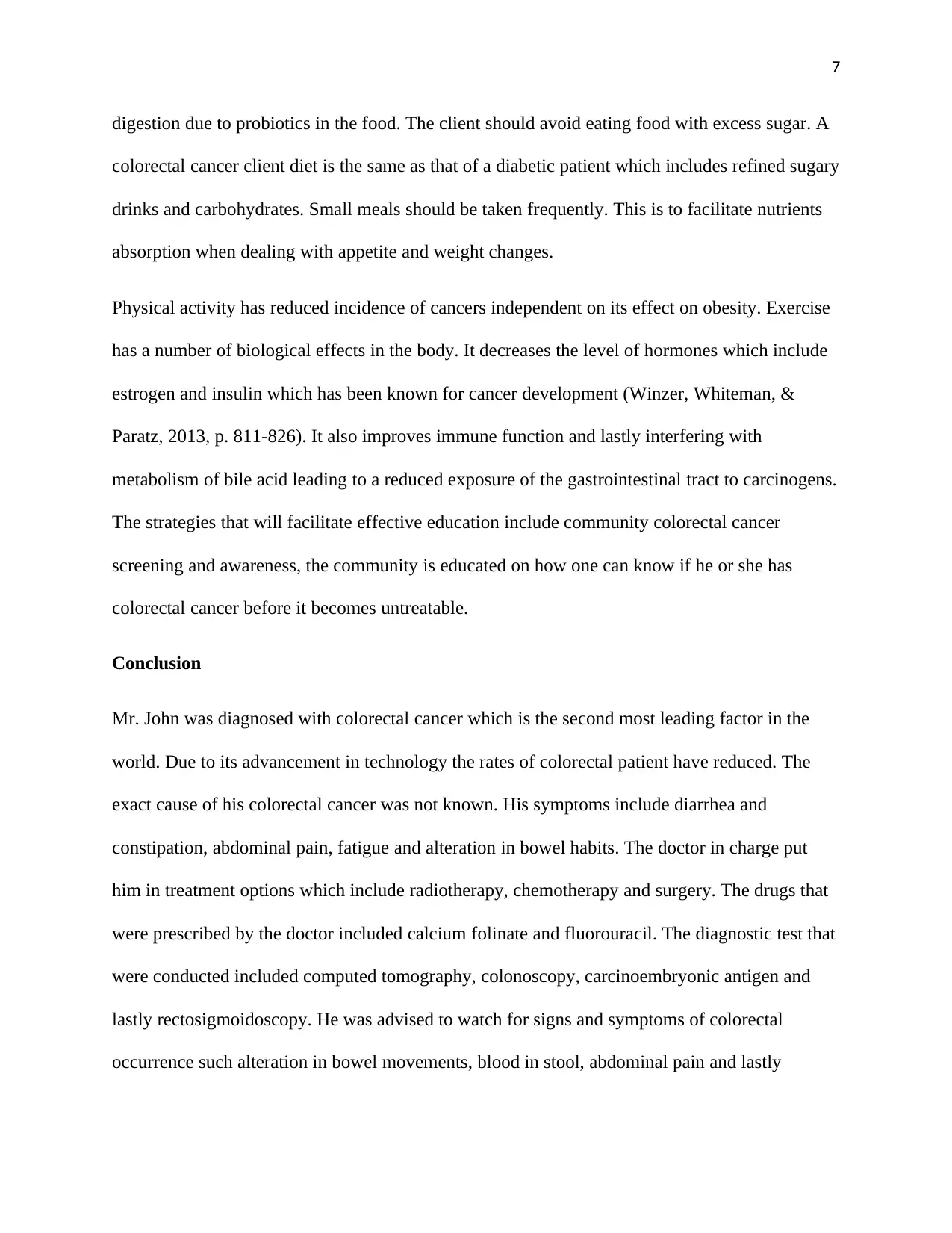
7
digestion due to probiotics in the food. The client should avoid eating food with excess sugar. A
colorectal cancer client diet is the same as that of a diabetic patient which includes refined sugary
drinks and carbohydrates. Small meals should be taken frequently. This is to facilitate nutrients
absorption when dealing with appetite and weight changes.
Physical activity has reduced incidence of cancers independent on its effect on obesity. Exercise
has a number of biological effects in the body. It decreases the level of hormones which include
estrogen and insulin which has been known for cancer development (Winzer, Whiteman, &
Paratz, 2013, p. 811-826). It also improves immune function and lastly interfering with
metabolism of bile acid leading to a reduced exposure of the gastrointestinal tract to carcinogens.
The strategies that will facilitate effective education include community colorectal cancer
screening and awareness, the community is educated on how one can know if he or she has
colorectal cancer before it becomes untreatable.
Conclusion
Mr. John was diagnosed with colorectal cancer which is the second most leading factor in the
world. Due to its advancement in technology the rates of colorectal patient have reduced. The
exact cause of his colorectal cancer was not known. His symptoms include diarrhea and
constipation, abdominal pain, fatigue and alteration in bowel habits. The doctor in charge put
him in treatment options which include radiotherapy, chemotherapy and surgery. The drugs that
were prescribed by the doctor included calcium folinate and fluorouracil. The diagnostic test that
were conducted included computed tomography, colonoscopy, carcinoembryonic antigen and
lastly rectosigmoidoscopy. He was advised to watch for signs and symptoms of colorectal
occurrence such alteration in bowel movements, blood in stool, abdominal pain and lastly
digestion due to probiotics in the food. The client should avoid eating food with excess sugar. A
colorectal cancer client diet is the same as that of a diabetic patient which includes refined sugary
drinks and carbohydrates. Small meals should be taken frequently. This is to facilitate nutrients
absorption when dealing with appetite and weight changes.
Physical activity has reduced incidence of cancers independent on its effect on obesity. Exercise
has a number of biological effects in the body. It decreases the level of hormones which include
estrogen and insulin which has been known for cancer development (Winzer, Whiteman, &
Paratz, 2013, p. 811-826). It also improves immune function and lastly interfering with
metabolism of bile acid leading to a reduced exposure of the gastrointestinal tract to carcinogens.
The strategies that will facilitate effective education include community colorectal cancer
screening and awareness, the community is educated on how one can know if he or she has
colorectal cancer before it becomes untreatable.
Conclusion
Mr. John was diagnosed with colorectal cancer which is the second most leading factor in the
world. Due to its advancement in technology the rates of colorectal patient have reduced. The
exact cause of his colorectal cancer was not known. His symptoms include diarrhea and
constipation, abdominal pain, fatigue and alteration in bowel habits. The doctor in charge put
him in treatment options which include radiotherapy, chemotherapy and surgery. The drugs that
were prescribed by the doctor included calcium folinate and fluorouracil. The diagnostic test that
were conducted included computed tomography, colonoscopy, carcinoembryonic antigen and
lastly rectosigmoidoscopy. He was advised to watch for signs and symptoms of colorectal
occurrence such alteration in bowel movements, blood in stool, abdominal pain and lastly
Paraphrase This Document
Need a fresh take? Get an instant paraphrase of this document with our AI Paraphraser

8
constipation. His health education included a well-balanced diet, regular exercise, avoiding areas
predisposed to cigarette smoke and lastly staying hydrated.
constipation. His health education included a well-balanced diet, regular exercise, avoiding areas
predisposed to cigarette smoke and lastly staying hydrated.
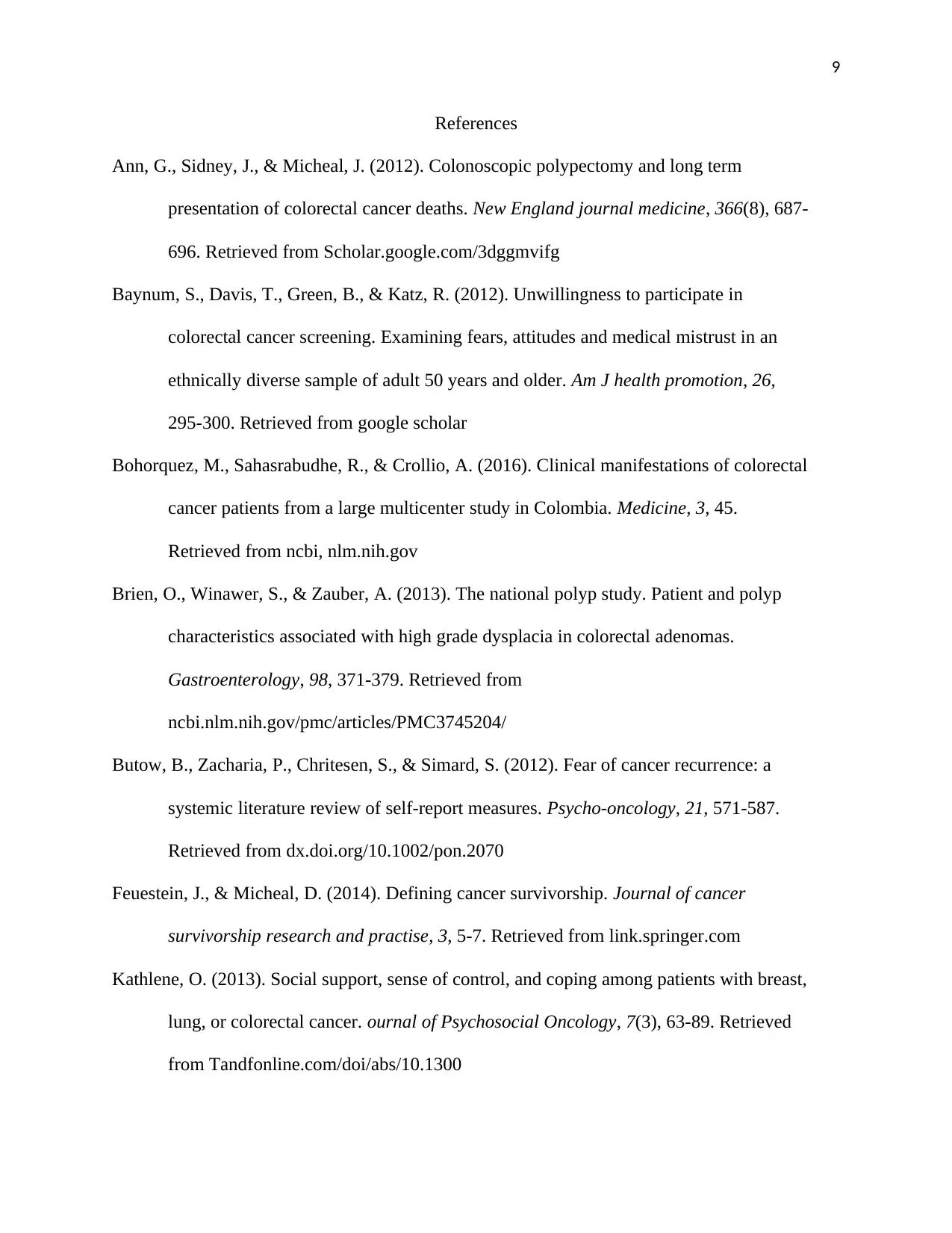
9
References
Ann, G., Sidney, J., & Micheal, J. (2012). Colonoscopic polypectomy and long term
presentation of colorectal cancer deaths. New England journal medicine, 366(8), 687-
696. Retrieved from Scholar.google.com/3dggmvifg
Baynum, S., Davis, T., Green, B., & Katz, R. (2012). Unwillingness to participate in
colorectal cancer screening. Examining fears, attitudes and medical mistrust in an
ethnically diverse sample of adult 50 years and older. Am J health promotion, 26,
295-300. Retrieved from google scholar
Bohorquez, M., Sahasrabudhe, R., & Crollio, A. (2016). Clinical manifestations of colorectal
cancer patients from a large multicenter study in Colombia. Medicine, 3, 45.
Retrieved from ncbi, nlm.nih.gov
Brien, O., Winawer, S., & Zauber, A. (2013). The national polyp study. Patient and polyp
characteristics associated with high grade dysplacia in colorectal adenomas.
Gastroenterology, 98, 371-379. Retrieved from
ncbi.nlm.nih.gov/pmc/articles/PMC3745204/
Butow, B., Zacharia, P., Chritesen, S., & Simard, S. (2012). Fear of cancer recurrence: a
systemic literature review of self-report measures. Psycho-oncology, 21, 571-587.
Retrieved from dx.doi.org/10.1002/pon.2070
Feuestein, J., & Micheal, D. (2014). Defining cancer survivorship. Journal of cancer
survivorship research and practise, 3, 5-7. Retrieved from link.springer.com
Kathlene, O. (2013). Social support, sense of control, and coping among patients with breast,
lung, or colorectal cancer. ournal of Psychosocial Oncology, 7(3), 63-89. Retrieved
from Tandfonline.com/doi/abs/10.1300
References
Ann, G., Sidney, J., & Micheal, J. (2012). Colonoscopic polypectomy and long term
presentation of colorectal cancer deaths. New England journal medicine, 366(8), 687-
696. Retrieved from Scholar.google.com/3dggmvifg
Baynum, S., Davis, T., Green, B., & Katz, R. (2012). Unwillingness to participate in
colorectal cancer screening. Examining fears, attitudes and medical mistrust in an
ethnically diverse sample of adult 50 years and older. Am J health promotion, 26,
295-300. Retrieved from google scholar
Bohorquez, M., Sahasrabudhe, R., & Crollio, A. (2016). Clinical manifestations of colorectal
cancer patients from a large multicenter study in Colombia. Medicine, 3, 45.
Retrieved from ncbi, nlm.nih.gov
Brien, O., Winawer, S., & Zauber, A. (2013). The national polyp study. Patient and polyp
characteristics associated with high grade dysplacia in colorectal adenomas.
Gastroenterology, 98, 371-379. Retrieved from
ncbi.nlm.nih.gov/pmc/articles/PMC3745204/
Butow, B., Zacharia, P., Chritesen, S., & Simard, S. (2012). Fear of cancer recurrence: a
systemic literature review of self-report measures. Psycho-oncology, 21, 571-587.
Retrieved from dx.doi.org/10.1002/pon.2070
Feuestein, J., & Micheal, D. (2014). Defining cancer survivorship. Journal of cancer
survivorship research and practise, 3, 5-7. Retrieved from link.springer.com
Kathlene, O. (2013). Social support, sense of control, and coping among patients with breast,
lung, or colorectal cancer. ournal of Psychosocial Oncology, 7(3), 63-89. Retrieved
from Tandfonline.com/doi/abs/10.1300
⊘ This is a preview!⊘
Do you want full access?
Subscribe today to unlock all pages.

Trusted by 1+ million students worldwide
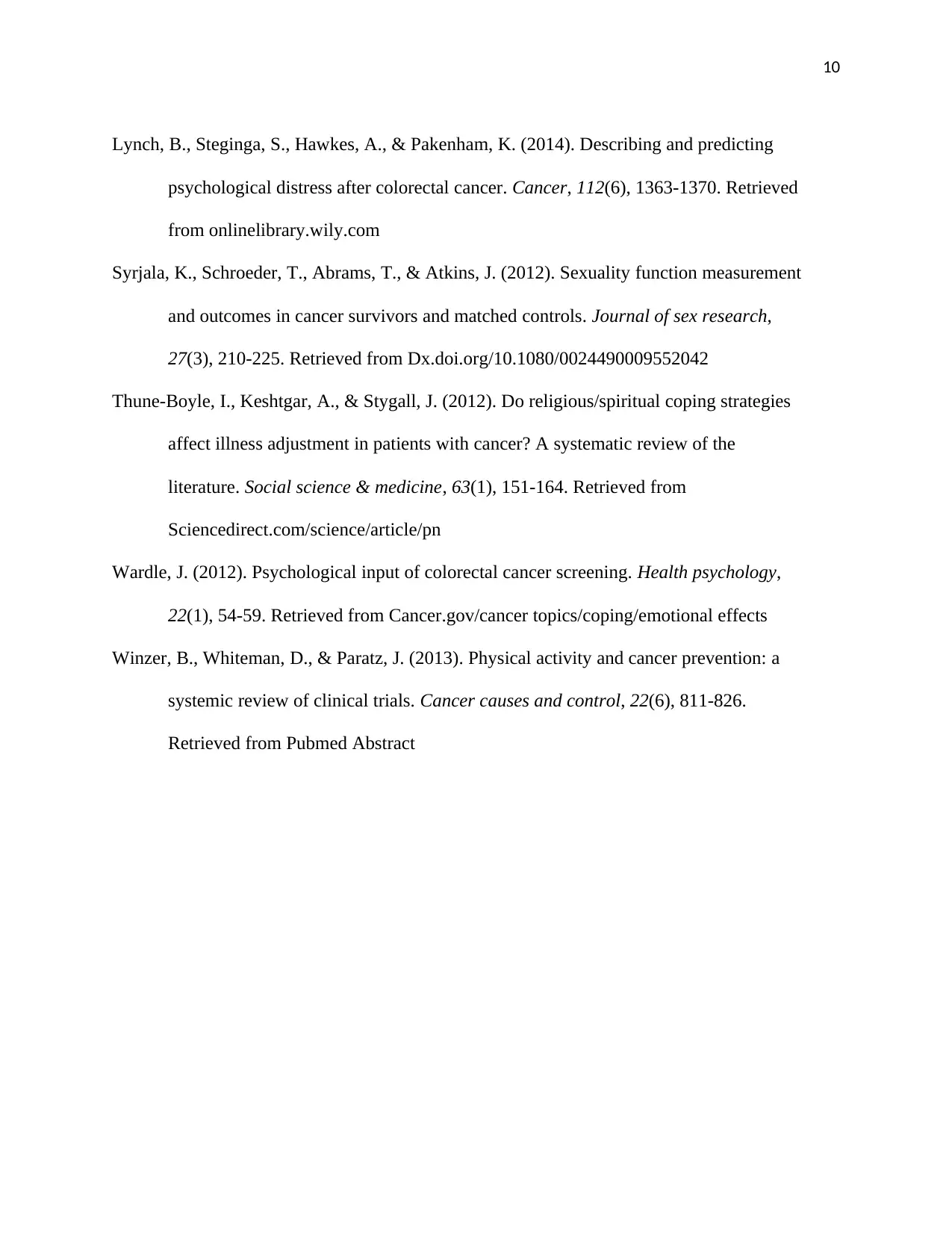
10
Lynch, B., Steginga, S., Hawkes, A., & Pakenham, K. (2014). Describing and predicting
psychological distress after colorectal cancer. Cancer, 112(6), 1363-1370. Retrieved
from onlinelibrary.wily.com
Syrjala, K., Schroeder, T., Abrams, T., & Atkins, J. (2012). Sexuality function measurement
and outcomes in cancer survivors and matched controls. Journal of sex research,
27(3), 210-225. Retrieved from Dx.doi.org/10.1080/0024490009552042
Thune-Boyle, I., Keshtgar, A., & Stygall, J. (2012). Do religious/spiritual coping strategies
affect illness adjustment in patients with cancer? A systematic review of the
literature. Social science & medicine, 63(1), 151-164. Retrieved from
Sciencedirect.com/science/article/pn
Wardle, J. (2012). Psychological input of colorectal cancer screening. Health psychology,
22(1), 54-59. Retrieved from Cancer.gov/cancer topics/coping/emotional effects
Winzer, B., Whiteman, D., & Paratz, J. (2013). Physical activity and cancer prevention: a
systemic review of clinical trials. Cancer causes and control, 22(6), 811-826.
Retrieved from Pubmed Abstract
Lynch, B., Steginga, S., Hawkes, A., & Pakenham, K. (2014). Describing and predicting
psychological distress after colorectal cancer. Cancer, 112(6), 1363-1370. Retrieved
from onlinelibrary.wily.com
Syrjala, K., Schroeder, T., Abrams, T., & Atkins, J. (2012). Sexuality function measurement
and outcomes in cancer survivors and matched controls. Journal of sex research,
27(3), 210-225. Retrieved from Dx.doi.org/10.1080/0024490009552042
Thune-Boyle, I., Keshtgar, A., & Stygall, J. (2012). Do religious/spiritual coping strategies
affect illness adjustment in patients with cancer? A systematic review of the
literature. Social science & medicine, 63(1), 151-164. Retrieved from
Sciencedirect.com/science/article/pn
Wardle, J. (2012). Psychological input of colorectal cancer screening. Health psychology,
22(1), 54-59. Retrieved from Cancer.gov/cancer topics/coping/emotional effects
Winzer, B., Whiteman, D., & Paratz, J. (2013). Physical activity and cancer prevention: a
systemic review of clinical trials. Cancer causes and control, 22(6), 811-826.
Retrieved from Pubmed Abstract
1 out of 10
Related Documents
Your All-in-One AI-Powered Toolkit for Academic Success.
+13062052269
info@desklib.com
Available 24*7 on WhatsApp / Email
![[object Object]](/_next/static/media/star-bottom.7253800d.svg)
Unlock your academic potential
Copyright © 2020–2025 A2Z Services. All Rights Reserved. Developed and managed by ZUCOL.




